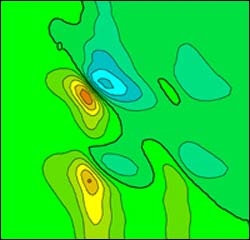NIST method may help optimize light-emitting semiconductors

What do you see in these Rorschach-blot-like images? JILA physicists see the once-hidden electronic behavior of semiconductors. The computer plots show how energy intensity (ranging from low in blue to high in red) varies as electronic structures called excitons absorblaser light and emit energy at various frequencies. The pair of similar "butterflies" indicates that an exciton is absorbing and emitting energy in a predictable pattern. Credit: JILA
Physicists at JILA have demonstrated an ultrafast laser technique for “seeing” once-hidden electronic behavior in semiconductors, which eventually could be useful in more predictable design of optoelectronic devices, including semiconductor lasers and white light-emitting diodes.
The work at JILA, a joint institute of the National Institute of Standards and Technology and the University of Colorado at Boulder, is described in the Feb. 10 issue of Physical Review Letters.
The technique manipulates light energy and wave patterns to reveal subtle behavior, such as correlated oscillations of two objects. Such correlations are important because they may allow researchers to more accurately predict the emission frequencies produced by an optoelectronic device based on its structure and semiconductor materials.
The method was developed originally by other researchers years ago for probing couplings between spinning nuclei as an indicator of molecular structure, and it led to a Nobel prize; more recently, scientists have been trying to use it to study vibrations in chemical bonds. The JILA team is the first to show the approach offers new insights into electronic properties of semiconductors. The use of light as a precision tool to manage electronic behavior could lead to improved optoelectronic devices.
In the JILA technique, a sample made of thin layers of gallium arsenide is hit with a continuous series of three near-infrared laser pulses lasting just 100 femtoseconds each. Trillions of electronic structures called excitons are formed. They consist of “excited” electrons and the “holes” they leave behind as they jump to higher energy vibration patterns. By changing the timing of the laser pulses and analyzing the wave patterns of the light and exciton oscillations, the JILA scientists figured out how to produce and identify correlations between absorption and emission of light from the material. The presence or absence of correlations can be seen in a computer plot of the frequency and wave pattern of the absorbed and emitted light. Correlations are revealed as a pair of similar butterfly-shaped plots.
Media Contact
More Information:
http://www.nist.govAll latest news from the category: Physics and Astronomy
This area deals with the fundamental laws and building blocks of nature and how they interact, the properties and the behavior of matter, and research into space and time and their structures.
innovations-report provides in-depth reports and articles on subjects such as astrophysics, laser technologies, nuclear, quantum, particle and solid-state physics, nanotechnologies, planetary research and findings (Mars, Venus) and developments related to the Hubble Telescope.
Newest articles

Silicon Carbide Innovation Alliance to drive industrial-scale semiconductor work
Known for its ability to withstand extreme environments and high voltages, silicon carbide (SiC) is a semiconducting material made up of silicon and carbon atoms arranged into crystals that is…

New SPECT/CT technique shows impressive biomarker identification
…offers increased access for prostate cancer patients. A novel SPECT/CT acquisition method can accurately detect radiopharmaceutical biodistribution in a convenient manner for prostate cancer patients, opening the door for more…

How 3D printers can give robots a soft touch
Soft skin coverings and touch sensors have emerged as a promising feature for robots that are both safer and more intuitive for human interaction, but they are expensive and difficult…





















